GALLUP NEWS SERVICE
PRINCETON, NJ -- May 17 marks the 50th anniversary of the landmark Supreme Court ruling on the Brown v. Board of Education case. In his opinion on the case, Chief Justice Earl Warren wrote, "We conclude that, in the field of public education, the doctrine of ‘separate but equal' has no place. Separate educational facilities are inherently unequal."
A review of Gallup Polls shows that most Americans endorse the court's ruling on the Brown case, and believe that educational opportunities for blacks are far better today than 50 years ago. Most blacks today are also satisfied with their own educations and their opportunities to succeed in life, but, at the same time, believe that black children today do not have the same educational opportunities as white children do. Whites are more positive than blacks on all three counts.
Americans' Satisfaction With Their Own Educations and Opportunities for Success
A June 2003 Gallup Poll asked Americans to rate their level of satisfaction with their educations and their opportunities to succeed in life. Eighty-seven percent of all Americans say they are satisfied with their educations, including 53% who are very satisfied. A majority of both whites and blacks say they are satisfied, but blacks are less likely to be satisfied than whites. Eighty-nine percent of whites are either very (54%) or somewhat (35%) satisfied with their educations. This compares with 78% of blacks who are satisfied, of which, 48% are very satisfied.
| Satisfaction With Personal Education by Race |
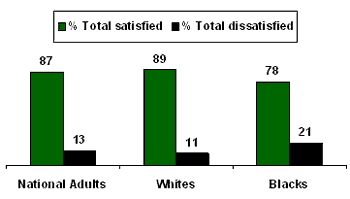 |
| June 12-18, 2003 |
Nearly 9 in 10 adults nationwide say they are either very (56%) or somewhat (32%) satisfied with their opportunities to succeed in life. Among whites, 92% are satisfied, including 61% who are very satisfied. Again, satisfaction is lower among blacks, with 77% of blacks saying they are satisfied (41% very and 36% somewhat satisfied).
| Satisfaction With Personal Opportunities to Succeed in Life by Race |
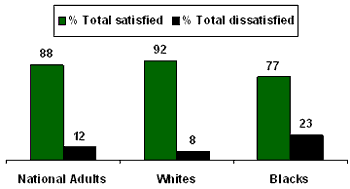 |
| June 12-18, 2003 |
Educational Opportunities for Blacks and Whites in the Country Today
Over the past several years, Gallup has asked Americans several different questions about equal educational opportunities for black children and white children in the United States. The results, perhaps not surprisingly, show substantial differences between white Americans and black Americans' attitudes.
Most recently, in an aggregate of polls conducted in January, February, and March 2004, Gallup found that 92% of whites surveyed feel educational opportunities for black children have improved over the past five decades, compared with 77% of blacks who feel the same way.
| Educational Opportunities for Black Children Compared With 50 Years Ago by Race |
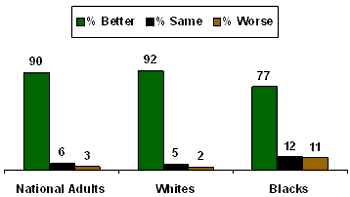 |
| January-March 2004 |
In the same aggregate of polls, Gallup also asked, "Do you think black children in the United States today do -- or do not -- have equal educational opportunities with white children?" A majority of all Americans, 59%, say black children have the same educational opportunities as white children do. However, the attitudes of whites and blacks form an almost completely opposite pattern. Sixty-three percent of whites agree that black children have the same educational opportunities as white children do, compared with only 31% of blacks.
| Equal Educational Opportunities for White Children and Black Children in the Country? by Race |
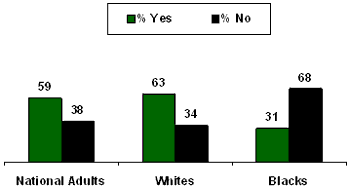 |
| January-March 2004 |
Despite these findings, blacks are somewhat less negative when it comes to educational opportunities in their own communities, based on the results from a different Gallup trend question that asks, "In general, do you think that black children have as good a chance as white children in your community to get a good education, or don't you think they have as good a chance?" The most recent results, from a late 2002 and early 2003 poll, show that 77% of all Americans say black children have as good a chance as white children in their communities do to receive a good education. Among whites, 81% feel this way. Among blacks, 50% say black children have as good a chance as white children in their communities do to get a good education.
These results are not significantly different from what they were 40 years ago, but this comparison masks the fact that there has been a substantial change in response to this question in the intervening years. In 1962, 53% of blacks said black children had as good a chance to get a good education as white children. The percentage of blacks agreeing averaged 59% in the late 1980s and early 1990s. By the mid-1990s, it averaged 64%. Then, the percentage began to drop, to 56% in 1999, 52% in 2001, and then reached its lowest point in history, 50%, in the most recent 2003 study. By comparison, the percentage of whites who said black children have as good a chance as white children do to get a good education has only ranged between 79% and 86% during this time period.
| Do Black Children Have as Good a Chance
as White Children to Get a Good Education? percentage saying as good a chance |
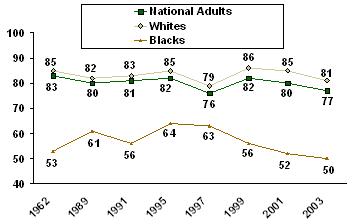 |
How to Improve Educational Opportunities for Black Children Today
According to the same aggregate of Gallup Polls from earlier this year, the American public says the most important way to improve the educational opportunities for black children is to provide them with the same standards or opportunities (at 11%), to encourage more family responsibility (at 10%), to offer better funding or financing in general (at 7%), and to hire better teachers (at 7%).
The results on this question generally show few major differences between whites and blacks, although blacks are more likely than whites to suggest better teachers and less likely to mention more family responsibility.
|
Most Important Way to Improve Educational
Opportunities for Black Children |
|||
|
|
|
Whites |
|
|
% |
% |
% |
|
|
Have the same standards/equal opportunity |
11 |
10 |
12 |
|
More family responsibility |
10 |
11 |
5 |
|
Better funding/financing in general |
7 |
7 |
9 |
|
Better teachers |
7 |
6 |
12 |
|
Greater encouragement to attend school |
5 |
5 |
7 |
|
Improve educational system overall |
4 |
4 |
5 |
|
Better schools/more schools |
4 |
4 |
5 |
|
Improve economic conditions |
4 |
4 |
4 |
|
Focus on funding the inner city schools |
4 |
4 |
2 |
|
Less discrimination/racism |
4 |
4 |
4 |
|
Allow a voucher system |
3 |
3 |
1 |
|
More help with scholarships/grants |
2 |
2 |
3 |
|
Better discipline |
2 |
2 |
2 |
|
More integration between poor and wealthy |
1 |
1 |
2 |
|
Early childhood intervention/development |
1 |
1 |
2 |
|
Smaller classrooms |
1 |
1 |
1 |
|
More help with war on drugs/crime in areas |
1 |
1 |
* |
|
End affirmative action |
* |
* |
1 |
|
Make school more affordable |
* |
* |
1 |
|
Other |
4 |
3 |
6 |
|
No opinion |
25 |
27 |
16 |
Historical Reactions to the Brown v. Board of Education Decision
Immediately following the Brown v. Board of Education decision in 1954, Gallup asked Americans if they approved or disapproved of the Supreme Court ruling that racial segregation in all public schools is illegal, meaning that all children, no matter what their race, must be allowed to go to the same schools.
The initial results, from a May 21-26, 1954, poll, found that 55% of Americans approved of the decision, and 40% disapproved. The results remained essentially unchanged in two additional polls conducted in 1954, including a June poll with 53% approval and a late December poll with 52% approval. Between 1955 and 1961, the percentages rose slightly, with roughly 6 in 10 Americans approving of the Brown v. Board of Education decision. Around the 40th anniversary of the ruling, in April 1994, an overwhelming 87% of Americans said they approved of the court's decision on this matter.
| Approval Ratings on U.S. Supreme Court Decision on Brown v. Board of Education |
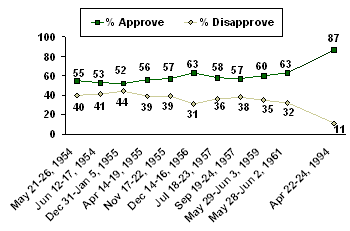 |
Even though a majority of Americans consistently said they approved of the Brown decision, opinions five years after the ruling show that the public seemed frustrated by the impact of the ruling. A May 1959 poll found that 53% of Americans said the decision caused a lot more trouble than it was worth. Thirty-seven percent of respondents said the decision did not cause more trouble than it was worth, and the rest had no opinion.
Survey Methods
These results are based on telephone interviews with a randomly selected national sample of 3,017 adults, aged 18 and older, conducted in several Gallup Polls in June 2003, and January, February, and March 2004. For results based on the total sample of national adults, one can say with 95% confidence that the margin of sampling error is ±2 percentage points. For results based on the sample of 2,595 whites, one can say with 95% confidence that the margin of sampling error is ±2 percentage points. For results based on the sample of 219 blacks, one can say with 95% confidence that the margin of sampling error is ±7 percentage points.
Results also are based on telephone interviews with 1,385 national adults, aged 18 and older, conducted June 12-18, 2003, including oversamples of blacks and Hispanics that are weighted to reflect their proportions in the general population. For results based on the total sample of national adults, one can say with 95% confidence that the maximum margin of sampling error is ±3 percentage points. Results for the sample of 821 whites, aged 18 and older, are based on telephone interviews conducted June 12-15, 2003. For results based on the total sample, one can say with 95% confidence that the margin of sampling error is ±4 percentage points. Results for the sample of 241 blacks, aged 18 and older, are based on telephone interviews conducted June 12-18, 2003. For results based on the total sample, one can say with 95% confidence that the margin of sampling error is ±7 percentage points.
In addition to sampling error, question wording and practical difficulties in conducting surveys can introduce error or bias into the findings of public opinion polls.
